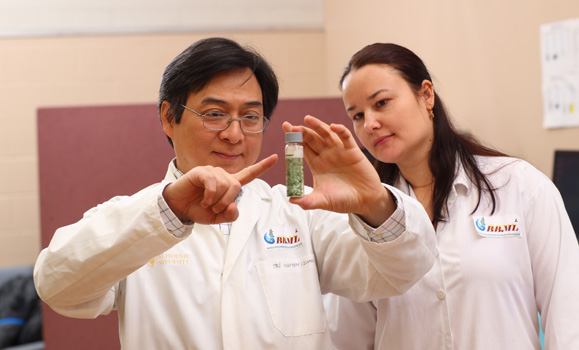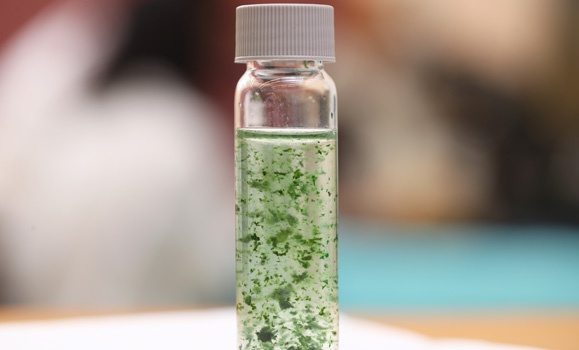

Over the past six years, Tri Nguyen-Quang’s research team in AV���ֲ�’s Biofluids and Biosystems Modeling Lab has been monitoring 13 lakes in Nova Scotia and New Brunswick. Blue-green algal blooms have been present in each one of them. Also known as cyanobacteria, blue-green algae microbes are notorious for their potential to produce water-contaminating toxins that make people sick, kill beloved pets, and disrupt the natural balance of an ecosystem. Blooms are on the rise in North America, prompting concerns about vulnerable sources of drinking water and public health. Nguyen-Quang’s research sheds light on this mysterious natural phenomenon.
During spring and summer, the lakes under Nguyen-Quang’s watch feature conditions that are known to favor blue-green algal blooms: shallow depths, warm temperatures, still waters, and excess levels of nutrients within the water (phosphorous and nitrogen, in particular). Often recognized by a smelly, slimy, blueish-green or reddish-brown scum at the water’s surface, these massive populations of cyanobacteria are considered harmful algal blooms (HABs) because of their potential toxicity. They can occur suddenly and without warning, sometimes even transforming the colour of entire lakes within a matter of days.
“So far, we cannot predict where and when blooms will happen,” says Nguyen-Quang, an associate professor in the Department of Engineering. The unpredictable nature of HABs has been of interest to Nguyen-Quang since 2007, when he first began combining his training in physics, mathematics and engineering to study algal bloom dynamics.
While blue-green algae are naturally occurring in many freshwater environments, they become a problem for cities and towns when their populations increase exponentially, leading to blooms. Luckily not all blue-green algal blooms are toxic, or produce enough of their cyanotoxins to be considered dangerous. But it takes specialized resources to test a water sample for toxin-emitting microbes, and those can be difficult to access in a timely manner.
Nguyen-Quang explains that high levels of cyanotoxins can cause adverse health effects in people if ingested, inhaled, or touched. Symptoms of exposure range from itchy skin and eyes to fever, gastrointestinal illness, and liver damage. The toxins can also harm or kill pets and wildlife. In 2018 and 2019, four dogs in New Brunswick died shortly after swimming in contaminated water, their necropsies proof that cyanotoxins were to blame.
In the interest of public health, water officials have no choice but to act quickly, treating any blue-green algal bloom as potentially unsafe until lab tests prove otherwise. Precautions include urging people to keep their families and pets away from the affected water and educating the public about the signs of a bloom. If lab tests come back positive for dangerous levels of toxins, the area can be closed to all recreational activity.
But when blue-green algae are detected in drinking water sources, protecting the public becomes far more complicated, says Dr. Nguyen-Quang. That happened recently in Moncton, NB when not one but two drinking water reservoirs contained blue-green algae. Fortunately, a non-toxic bloom occurred in only one of them, a back-up supply, and water in Moncton remained safe to drink. Nevertheless, repeated instances of cyanobacteria in that watershed seem to have prompted an imminent $6-million upgrade to Moncton’s Turtle Creek water treatment facility, which was announced last fall.
The effects of climate change likely have a role to play in the increasing frequency of blue-green algal blooms, explains the associate professor. For example, his team has observed blooms in Nova Scotia occurring as late as December. It was a surprising observation, says Nguyen-Quang, because the current scientific literature suggests blooms in our region of the world typically occur between spring and early fall. So, now Nguyen-Quang is partnering with researchers around the world in an effort to better understand the relationship between local conditions and the environments in which toxic algal blooms thrive.
“[Humans] thought we could dominate nature, but we were completely wrong,” says Nguyen-Quang, who believes in the power of balance and harmony, values he attributes to his Asian heritage and culture. “When [humans] go about life in an unbalanced way, I believe nature reacts to us with these kinds of phenomena.”
 When he began his position with the Faculty in 2011, Nguyen-Quang says there was very little data on blue-green algae in Nova Scotia, and that’s one of the reasons he felt his research program would be well-suited here. Home to over 3,000 lakes, Nova Scotia provides ample opportunity for the collection of biological, physical, and chemical data — data that will help Nguyen-Quang decipher the code, so to speak, that programs the development of blue-green algal blooms.
When he began his position with the Faculty in 2011, Nguyen-Quang says there was very little data on blue-green algae in Nova Scotia, and that’s one of the reasons he felt his research program would be well-suited here. Home to over 3,000 lakes, Nova Scotia provides ample opportunity for the collection of biological, physical, and chemical data — data that will help Nguyen-Quang decipher the code, so to speak, that programs the development of blue-green algal blooms.
“I’m trying to detect and understand messages from nature, and then I will use mathematics as a tool to describe those messages,” explains Nguyen-Quang. Data from a number of lakes over a number of years is required to do so, he adds, emphasizing the importance of continued funding for further research.
Having enough data, he says, is key to discovering the universal threshold of a toxic bloom. In other words, Nguyen-Quang’s team is working to uncover the precise conditions required to push a freshwater ecosystem past the point of effectively controlling its cyanobacteria population, in addition to identifying factors that lead to toxicity. Then, he explains, he can develop a mathematical model that predicts where, when and how a bloom will form—a powerful tool that could help governments optimize their approaches to water management, treatment, and protection. It’s a feat not yet possible, but paramount in a future shaped by climate change.
��
Recent News
- MacRae Library Summer Hours
- Faculty of Agriculture students win the top awards at the Science Atlantic conference
- Annual Sustainability and Transportation Survey
- Engineering banquet brings students, faculty together in celebration of community
- Engineering Excellence: Students triumph at Atlantic competition, earn National silver
- Engaging with the African Nova Scotian Community
- The Dal AC International Guest House is Now Open!
- Dal AC International expands global learning with GSO funding

